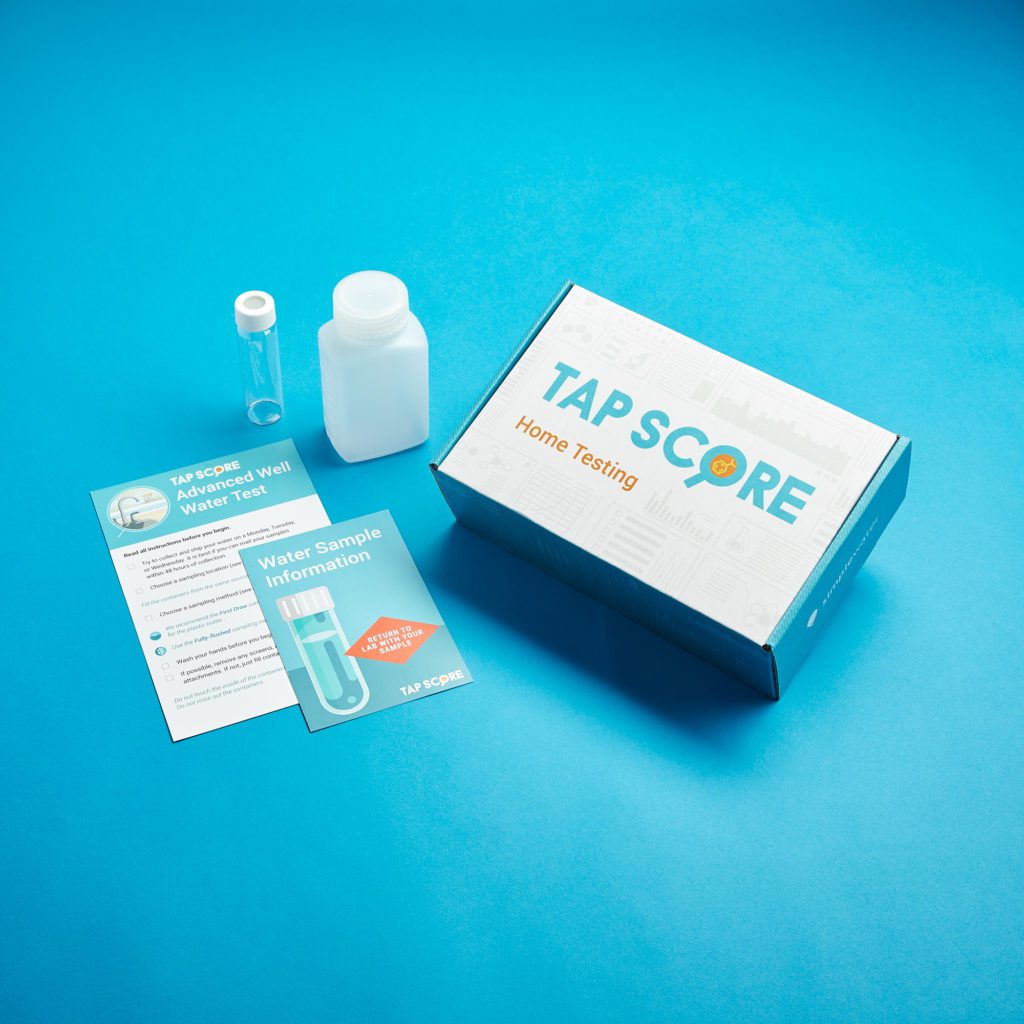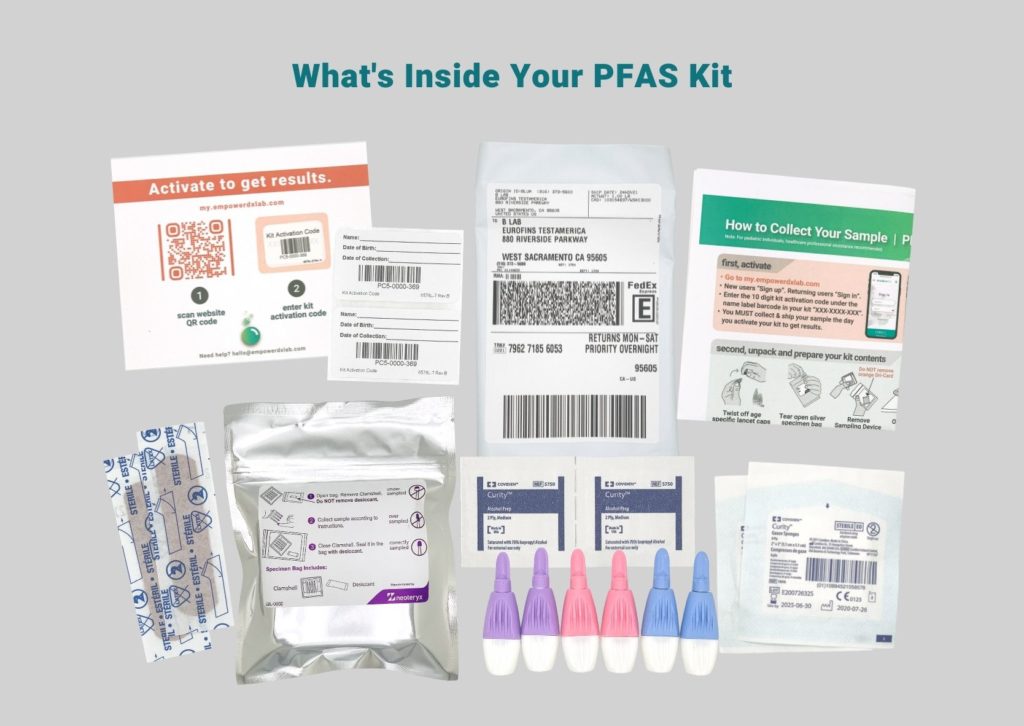PFAS chemicals have been in the news quite a bit lately:
- In June 2022, the EPA significantly lowered the “safe limits” of a few specific PFAS, indicating that even very small amounts can be dangerous.
- Then researchers found PFAS in the rain which exceed those “safe levels” set by the EPA… even in remote parts of Antarctica.
- And in a more hopeful headline, scientists revealed they may have actually found a way to destroy these “forever chemicals.”
Then PFAS made headlines again when the National Academies of Sciences, Engineering, and Medicine (NASEM) released a report recommending that the CDC advise doctors to offer PFAS blood testing to patients who may have had increased exposure to these toxicants.
The hope is that this kind of testing will not only help individuals monitor and treat health concerns caused or exacerbated by PFAS early on, but that the data collected will help regulatory bodies deal with our PFAS problem on a societal level as well.
So, if you’re curious about testing yourself or your water to see what your PFAS exposure might be, you’ve come to the right place! In this article, we’ll tell you who should consider testing for PFAS and then give you our top recommendations for at-home water and blood PFAS tests.
Table of Contents
This article contains affiliate links, which means we may earn a commission if you decide to make a purchase. We only make honest recommendations.
Featured Image Credit: Tap Score
A Quick PFAS Primer
First, in case you need a quick summary on PFAS:
PFAS stands for per- and polyfluoroalkyl substances. Sometimes, they’re also referred to as per- and polyfluoroalkyl chemicals, or PFCS.
More than 9,000 different kinds of PFAS have been identified so far. When you see the acronym “PFAS,” it’s referring to the entire class of chemicals.
The most well-researched PFAS include PFOA and PFOS, but other names you may have heard of include GenX, PFNA, PFTE, and PFHxS.
PFAS have earned the nickname “forever chemicals” because they don’t easily break down in our bodies or the environment—they just keep building up over time. (Recently, researchers may have actually found a way to break down PFAS, but it’s still early so we will have to wait and see how this pans out!)
PFAS are found in all kinds of consumer products, including non-stick cookware, food packaging, and water-resistant clothing & gear such as camping tents, rain jackets, boots, and more. PFAS are also widely used in manufacturing of all kinds, which is one of the big ways these chemicals get into our waterways, soil, and other consumer products.
There are all kinds of negative health effects associated with PFAS exposure, including cancer, high cholesterol, high blood pressure, thyroid dysfunction, ulcerative colitis, immune deficiencies, and more.
Home
Here’s a List of Products with PFAS (& How to Avoid Them)
PFAS “forever chemicals” are in the news a lot these days. Here’s a list of products with PFAS to help you decrease your exposure.
Who Should Test For PFAS?
Considering that everyone comes into contact with PFAS in one way or another, anyone and everyone could potentially benefit from testing themselves and their water for PFAS.
However, there are certain populations that are at an even higher risk for PFAS exposure and therefore may want to even more strongly consider getting tested. Those individuals include:
- Those who work or have worked in manufacturing settings that utilize fluorinated compounds
- Firefighters and those who have been exposed to firefighting foam
- People who work or have worked in other industries that regularly come into contact with PFAS, such as carpet installers/cleaners and ski shop employees
- Those who live on or near military bases
- Those who live near an area that has been contaminated by PFAS (you can use this map to check where you live)
- Those who have chronic health conditions (cancer, autoimmune disease, thyroid disorders, etc.)
- Pregnant people and those who may become pregnant
- Individuals who regularly eat take out or fast food
And now that there are a few easy at-home PFAS test kits available, anyone who is just concerned or curious can test themselves too! Here are the two tests we recommend checking out:
The Best At-Home PFAS Test Kit for Your Water: Tap Score

Tap Score is actually one of the very first companies to make extensive water testing available for consumers. They have a really wide range of test kits, including two that are specifically for PFAS.
The “PFAS Water Test Kit” ($299) tests for 14 of the most common PFAS chemicals, including PFOA and PFOS. The “GenX and PFAS Water Test” ($515) is a more comprehensive one that tests for 25 different types of PFAS, including newer ones such as GenX.
Tap Score makes it super easy for you to test your water for PFAS chemicals: they ship you an at-home test kit, you gather your water samples and ship them back, and then you get a full report on what’s in your water.
Shipping is free both ways, there is a 10-12 day turnaround time, and they even offer a 100% satisfaction guarantee.
And if you want to test for other contaminants in your water, you can do that too. They offer a few different “Essential” kits for both city and well water (as well as rain and spring water!), or you can shop from their collection of specialized tests, too. So you can specifically test for heavy metals, pesticides such as glyphosate, microplastics, biological contaminants like mold and E. coli, and more.
The Best At-Home PFAS Test Kit for Your Blood: empowerDX

If you’d like to test your blood for PFAS, empowerDX makes it easy for you to do in the comfort of your own home. Their PFAS Exposure™ Blood Test ($399) looks for over 40 different PFAS chemicals, including PFOA, PFOS, and GenX.
After you make your purchase, you’ll get a test kit delivered to your home. You’ll collect your blood sample with an easy finger prick and then ship it back (shipping is included in the cost). Then after 4-5 weeks, you’ll get your physician-reviewed test results.
It’s important to note that current PFAS blood tests are for research and educational use only. They’re not meant to diagnose anything and you can’t necessarily be “treated” for PFAS exposure at this time. But for those who have been exposed or are at higher risk for the negative health effects of PFAS exposure, it can be very valuable information to take into consideration as you and your doctor monitor and care for your health moving forward.
Oh, and FYI, this test is eligible for HSA/FSA purchasing!
What Do You Do Next?
So, what should you do after you get your test results back? What if you find out that you have elevated levels of PFAS chemicals in your blood?
Unfortunately, it’s extremely difficult (if not almost impossible) to “detox” from PFAS. The half-life of PFAS chemicals are around 3.5 to 8 years, which means it would take that long for the amount of PFAS in your body to be cut in half… And that would only be if you weren’t exposed to any new PFAS during that time, which we know is impossible.
Needless to say, that can be really frustrating and overwhelming. But here’s what you CAN do:
1. Focus on what you can control.
When it comes to environmental toxicants, there is a lot you can’t control. And the stress of trying to control everything can also be toxic to your health!
So as you educate yourself and continue on your journey toward reducing your toxic burden, do your best to focus on what you CAN do and try not to obsess over the rest. Strive for progress, not perfection.
2. Avoid PFAS (and other toxicants) where you can.
Since we can’t “detox” from PFAS very easily, the best approach is avoidance. That means doing things like:
- filtering your drinking water (reverse osmosis is usually best for PFAS, but activated carbon will usually reduce them as well)
- avoiding water- and stain-resistant fabrics in things like furniture and outdoor gear
- switching to non-toxic cookware (such as cast iron)
- reducing fast food/take-out consumption
Reducing your exposure to other toxicants can help, too, since all of these toxins can all add up to create an overwhelming toxic burden that trigger health concerns. Some things you can do to avoid other types of environmental toxins include:
- avoiding bisphenols like BPA and BPS when possible (like switching to plastic-free food storage containers)
- avoiding synthetic fragrances in air fresheners, cleaning products, personal care products, etc.
- eating organic food when you can
- being mindful of certain foods that can be contaminated with heavy metals, such as fish that are high up on the food chain
- monitoring leaks and humidity levels in your home to prevent mold
- avoiding cigarette smoke
3. Monitor your health with a (good) doctor.
Education, awareness, and general monitoring can go a long way in overall wellbeing and vitality. If you and your doctor are aware of the potential health risks of PFAS exposure and what to look out for, then you can keep your eyes out and put preventative measures in place and/or start treatment early if necessary.
Considering that the research on PFAS is still relatively new, it’s important that you find a doctor that listens to your concerns and is willing to learn and keep up with the latest research. After all, most conventional MDs only get about seven hours of education on environmental toxicants during medical school.
If your doctor dismisses your concerns or is condescending about this issue, it might be time to find a new doctor!
And in case it’s helpful, the Agency for Toxic Substances and Disease Registry (ATSDR) released this guide to help you talk to your doctor about PFAS.
4. Demand more from government representatives as well as corporations.
Another thing you can do to help reduce your PFAS exposure in the long-term is to be an active citizen. Call or write to your representatives and make your voice heard. Tell them that we need more testing and regulations on the corporations who poison our waterways, soil, and consumer products. Even though there are some bans on certain PFAS in a few contexts, there are not currently any outright bans on the entire class of chemicals. (The E.U. is currently considering a proposal that would ban all PFAS, which would be the first of its kind.)
You can also call or write to the companies you shop from and ask them to put PFAS action plans in place. Check out this score card to see which brands are doing the best and worst when it comes to phasing PFAS out of their products.
So what do you think — will you be testing yourself for PFAS?
If you want to get more tips & tricks on how to avoid environmental toxins delivered to your inbox each week, sign up for Filtered Fridays!






Why are these tests so expensive? If these chemicals are so dangerous, it appears these test companies are profiteering based on the fear factor and assumed “need” for a test. A simple blood test won’t do? Sad. Please share more on how to get a reasonably priced test.
Hi Gregory,
I totally agree with you. These chemicals shouldn’t even be in our environment in the first place. I am continually frustrated about the fact that the burden of minimizing environmental toxicants is placed primarily on the individual, and that it takes a significant amount of resources (money, energy, etc) to do so. So, I’m with you there and absolutely empathize.
As far as the “need” for a test, I wouldn’t necessarily say that everyone “needs” to test their blood for PFAS unless there is something specific that you are trying to monitor with regard to your health. And those who live in certain areas—like a military base, a PFAS production facility, or somewhere where there is a known PFAS “spill” may want to do these tests for legal purposes. But to be honest, the average person could probably just assume that there are PFAS in their blood without getting a test (that’s based on the fact that other testing has shown that 97% of Americans do). Also, if you DO decide to get tested, make sure to check to see if you can use your HSA/FSA to purchase because many of the tests ARE HSA/FSA eligible.